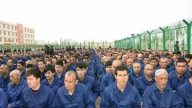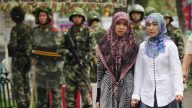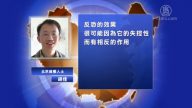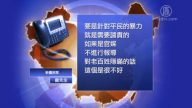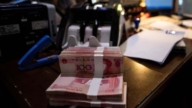【新唐人2014年05月08日訊】週二,中國國際關係學院「國際戰略與安全研究中心」,發佈了首部《國家安全藍皮書》,強調恐怖活動呈現高發狀態,已成為威脅國家安全的最大問題。評論分析,中國最大的「恐怖主義」份子是中共本身。
這份題為《中國國家安全研究報告(2014)》的藍皮書,是由「國際關係學院國際戰略與安全研究中心」和《社會科學文獻出版社》聯合發佈,對去年中國國家安全形勢進行回顧、評估與分析。
藍皮書指出:中國境內恐怖活動相對前幾年,處於活躍期,報告統計,去年中國境內的所謂暴力恐怖主義襲擊共10起。
藍皮書認為,中國的恐怖活動呈現出地域擴大的趨勢,和以政府機構和軍警為主要襲擊目標,以及恐怖勢力使用冷兵器等簡陋工具作案的新特點。
中國現代國際關係研究院副院長馮仲平說:「目前國內安全面臨的最大威脅之一就是暴力恐怖主義。」
國際上針對「恐怖主義」一詞,主要是指為達成宗教、政治或意識形態上的目地而有意製造恐慌的暴力行為。
美國哥倫比亞大學訪問學者陳破空:「在中共的定義裏面,如果用暴力的叫做恐怖份子。不用暴力的,比如說,學伊斯蘭教的主張民族自治,主張民族獨立的,它可能也叫恐怖份子,叫和平的恐怖份子,所以中共這個定義非常廣泛,它打擊面很廣,豎敵很多。」
美國「哥倫比亞大學」訪問學者陳破空指出,加上中共高壓的、強硬的治疆政策,以及對各個階層民眾的打壓,激起了越來越多的反抗。
香港《開放》雜誌總編輯金鐘:「從根本上來講呢,我覺得共產黨的暴力理論啊,它們從來沒有批評過,批判過,反省過,為甚麼?因為它們整個政權就是靠暴力得到的嘛,槍桿子裏面出政權嘛,所以它根本就否認這種用和平,用民主的方式來建立一個國家,來建立一個制度。」
時政評論員汪北稷指出,中共以暴力革命起家,從第一代黨魁毛澤東開始就擅長武裝鬥爭,共產黨的宣言以及它的行為準則、它的話語裏面,倡導的都是暴力。
時政評論員汪北稷:「現在當一些民族問題的激化,貧富問題的激化,社會暴動的激化,造成了中共本身也成為暴力的襲擊目標的時候,它來反對所謂的暴恐,但是暴力恐怖問題它是有原因的,它的根源還是在社會的矛盾當中存在。」
汪北稷舉出:中國目前的貧富差距,民族問題,社會階層問題,貪污腐敗,環境惡化等社會矛盾,都可能導致某些群體的心理絕望,而選擇報復政府和社會。
汪北稷:「但是有一些公安機關,政府部門啊成為暴力恐怖襲擊的目標,它們需要反思它們自己的過去的所作所為。」
中共發佈藍皮書當天,廣州火車站再次發生持刀砍人事件,造成6人受傷。這是近兩個月來,發生在大陸火車站的第3起恐怖血案。
4月底,新疆烏魯木齊火車站發生血案,造成3死70多人受傷﹔而3月初,雲南昆明火車站已發生砍人事件,導致29人死,140多人傷﹔去年10月,天安門廣場發生駕車撞人事件,導致5人死,多名行人受傷。
這些血案都被中共定性為恐怖襲擊。藍皮書強調,所謂「三股勢力」在新疆和西藏製造的恐怖襲擊事件,背後都有深刻的國際背景。
陳破空:「中共把維吾爾人定義了三種勢力,一種叫做宗教極端勢力,一種叫民族分裂勢力,一種叫暴力恐怖勢力,實際上這三種勢力,中共定義完了,都定義它自己,因為民族分裂是中共造成的。」
陳破空指出,新疆、西藏幾千年來都與漢人相安無事,但中共建政以來,以暴力手段和恐怖主義對付維吾爾人和藏人,所以說,最大的「恐怖主義」份子是中共本身。
採訪編輯/李韻 後製/舒燦
With Frequent Attacks Occurring, Communist China Publishes First Security Blue Book
On May 7, China released its first national
security blue book.
It emphasizes rising terrorist attacks in China
has become the biggest national security threat.
However, experts say that the biggest terrorist in China
is the Chinese Communist Party (CCP).
The Blue Book was jointly published by China ‘s University
of International Relations and Social Science Academic Press.
It reviews and analyzes China ‘s national security
status in 2013.
The Blue Book states that terrorists are in an active period
compared to years past.
The report states that there were 10 “terrorist attacks"
in China last year.
The Blue Book suggests that terrorist attacks in China
have expanded to targeted regions.
They are mainly aiming at government organs,
the police and the army.
It says the recent pattern of terrorists is to use simple
tools to commit crimes.
Feng Zhongping, deputy director of China Institutes
of Contemporary International Relations says that
the biggest security threat is violent terrorism.
Among the international community, terrorism refers
to those violent acts that are intended to create terror
or are perpetrated for a religious, political or ideological goal.
Chen Pokong, visiting scholar, Columbia University:
“The CCP defines a terrorist as one who uses violence.
If there is no use of violence, for example, learning
from Islam ‘s idea of national autonomy and independence,
the CCP likely calls it terror or peaceful terror.
Thus the CCP stretches the definition of terrorism, and in this
way, it purges large areas, creating many enemies."
Chen Pokong points out that the CCP ‘s brutal suppression,
forceful implementation of the Xinjiang policy
and suppression of people from all walks of life
has sparked a growing resistance.
Jin Zhong, Chief Editor of Hong Kong ‘s Open Magazine:
“Fundamentally speaking, I think the party has never
criticized or reviewed its theory of violence.
Why?
Because the CCP obtained its power by using violence,
saying ‘power grows from the barrel of the gun. ‘
So, they completely deny that the establishment of a nation
or a system should follow the way of peace and democracy."
Wang Beiji, current affairs commentator, says that the CCP
grew out of violence, beginning with its first generation –
Mao Zedong– who was good at struggle.
Its words in the Declaration of the Communist Party
and its code of conduct advocate violence.
Wang Beiji: “Now ethnic conflict, problems between poor
and rich, and the social violence have intensified,
and the CCP has become the target of attackers.
In this regard, the CCP began implementing
‘anti terrorism.However ‘, there are reasons for the terror,
the root of the cause exists inside the social conflicts."
Wang Beiji listed the wealth gap, ethnic issues,
social class issues, corruption, environmental deterioration
and more, as causing despair in certain groups, which has
lead people to retaliate in the government and society.
Wang Beiji: “Some police stations and governmental organs
become terrorists targets, they must examine
its past behaviors."
The same day the Blue Book was released, a knife attack
took place again at the Guangzhou Railway station.
Six people were injured.This is the third bloody railway station attack
in China within two months.
At end of April, a massacre occurred at Urumqi Railway
Station in Xinjiang Province.
Three people died, 70 were injured.At beginning of March, a knife attack took place at Kunming Railway Station in Yunnan.It caused 29 deaths and 140 injuries.
In October 2013, a Tiananmen Square car crash incident
killed five people and injured many bystanders.
The CCP classified these incidents as terrorist attacks.
The Blue Book stresses that the “three forces" that caused
the Xinjiang and Tibet attacks are being influenced
by international terrorism.
Chen Pohong: “The CCP classified Uyghurs
into three forces— the religious extreme force,
ethnic separation force, and the violent terrorism force.
Actually, all the three categories created by the CCP can be reversed back on itself.Because the ethnic separation was caused by the CCP."
Chen Pokong points out that Uyghurs and Tibetans have
gotten along well with Han people for thousands of years,
however, when the CCP took over the country, they used
violence and terrorism to deal with Uyghurs and Tibetans.
Thus the CCP is the largest terrorist.
Interview & Edit/Liyun Post-Production/SuCan


